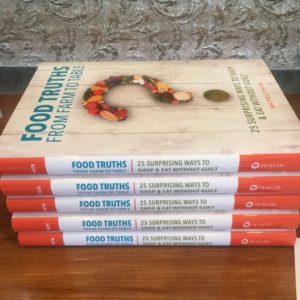Why Food Truths? A look inside the book
“I just want to have food that is good for my family. Why does it have to be so difficult?”
This was the question I kept hearing from a group of moms gathered around a long kitchen table on a cold January day.
We talked about the agony of going to the grocery store. The guilt. The confusion.
“I don’t have enough time to be researching all of this information. I just want to feed my family food I can trust. How can food be less confusing?”
In between sharing stories of our kids over coffee and laughter, the questions continued for over two hours. It became apparent they just want to feel good about the food they feed their family.
“Why is finding the right food so confusing?” I asked them.
As Ellen, a mom with four kids under the age of 11, said, “I don’t know what to believe anymore. One year they tell us to avoid eggs, the next year we’re supposed to only eat meat on certain days of the week and last week fruits were villains. I just want to be able to have food for my family that I know is healthy for them.”
I understand that. Like you, I’m trying to do the best thing for my family, especially when it comes to nutrition and health.
When I was speaking for a group of dietitians two years ago, I heard over and over people are confused about their food – and a big part of that is not knowing how it is produced. “Where does our food come from? How can we trust it if we don’t know who is producing it and what they are doing?” asked a registered dietitian in the first year of her career.
I thought, “Isn’t it common sense that ranchers and farm families are growing the plants and animals to feed you?”
I have come to understand the people – and stories – of agriculture are common sense to me because I grew up in agriculture. My roots are firmly planted in the world where food is grown.
Two-thirds of the U.S. population is in cities. Many have never even visited a ranch or a farm. The majority of the Canadian and U.S. population is three to four generations removed from the farm. They have no idea how the food they eat each day is produced until someone tells them. Hence the confusion – and the opportunity to easily buy into misinformation.
The moms at the table told me “You really need to write a book about this. We want to know what you buy at the grocery, so make it a book we can take to the store with us so we can use it when we’re buying food.”
A red flag popped up in my brain. “Write another book? I’m busy enough already. Besides, there are so many books telling us what to eat or not eat. Who needs another book about food when people feel like they need a science degree and detective just to get through the grocery store?”
Then I realized “But there aren’t books out there from a rancher or farmer’s perspective that actually takes you behind the scenes of today’s agriculture in the U.S. and Canada. We need a book that lifts the curtain on the people growing food, how they do it – and why they are in farming and ranching”
Why this book?
Those were the thoughts going through my head as I considered writing this book. I have an abundantly “full life” between being a mom, running a business that requires a lot of travel, tending to cattle, volunteering, etc.
Yet I couldn’t stop thinking about what those women said, knowing they represented millions who want, need and deserve to feel good about the food they buy. In order that to happen, they deserve to know the truth from the people who are growing their food to understand and trust it.
It became too important of an issue for me to ignore. I’ve had a firsthand perspective of the families growing your food for 40 years.
So I wrote this book – not because I want to push my farm views on you. Not because I need my name on a cover. Not because I believe I have all of the answers.
I do offer a viewpoint contrarian to fashionable food; one to help you trust the intentions and process in farming and ranching.
I wrote this book because I care about honoring the truth. I care about choice – both on the plate AND on the farm. I care about parents not feeling guilty when they go to the grocery store and can’t afford the “right” label. I care about people not being judged because of what is on their plate or in their grocery bag. I care how instant experts are disparaging farmers and ranchers without knowing what they’re talking about. I care that time-crunched parents can buy food – regardless of the brand – with confidence it is safe. I care about children understanding marketing on their food and knowing the real truth in how food is raised. I care about getting back to the truth in food – raised the right way by the right people for the right reasons.
If taking the time to read this book helps you buy, prepare and enjoy food with confidence – my work-translating farm to food will be worth it. I hope you’ll keep it in your kitchen as a reference. If Food Truths from Farm to Table gives you permission to be smart about your food, my mission is accomplished.
After a lifetime as a farm girl and 15 years of working as a professional speaker to bring people together around the plate, I thought the confusion and emotional hysteria around food would die down. I hoped the activists manipulating food companies and consumer minds would move on. I expected journalists with no agricultural background would be called out for their one-sided writing. I assumed people would see through marketing claims being made on food labels. I figured facts would prevail over shoddy science.
I was wrong.
The confusion and emotional battleground continues. The marketing is getting bigger. The misinformation grows. Activists continue to bully. Celebrities and politicians take opinion-based positions instead of looking at the facts. As a result of all of this, food buyers are filled with guilt, confusion and overwhelm. And the people growing food are left to wonder what happened.
The food hysteria is not going away, it’s getting worse.
Let’s make this simple; food is a basic necessity. We eat to sustain life. Not to make a political statement. Not as a status symbol. Not because of a claim on a package. Food is sustenance. My hope is that this book returns us to that fundamental belief.
How is this book organized?
Food Truths from Farm to Table walks you through aisles of the grocery store, from eggs to cereals to the deli. I created these nine sections for practical purposes of creating a visual of your food shopping experience, then wrote chapters around the most significant issues found in my research. 25 food truths are embedded throughout the book. These food truths are a result of the questions I’ve fielded from a variety of audiences – and know people need answered about their food. The 25 truths are also what I believe are at the heart of the divide between food and farm.
 This book brings a voice of reason to the overly sensationalized food and health arena. My hope is that food truths from the people producing your food are a valuable and unique perspective. I want to arm you with the truths about food to simplify your food buying experience. My goal is to provide practical evidence in an emotional arena often filled with knee jerk reactions. You may not agree with everything I write – and that’s O.K., I welcome debate.
This book brings a voice of reason to the overly sensationalized food and health arena. My hope is that food truths from the people producing your food are a valuable and unique perspective. I want to arm you with the truths about food to simplify your food buying experience. My goal is to provide practical evidence in an emotional arena often filled with knee jerk reactions. You may not agree with everything I write – and that’s O.K., I welcome debate.
This book will give you a different window into the food world to simplify your food shopping, reduce your guilt, and give you freedom to enjoy food. A window of what’s really happening on farms and ranches – one that leads you to think about food truths whenever you eat or buy food.
This blog is an excerpt from No More Food Fights: 25 Surprising Ways to Shop & Eat Without Guilt, which will be released on March 20, 2017.



